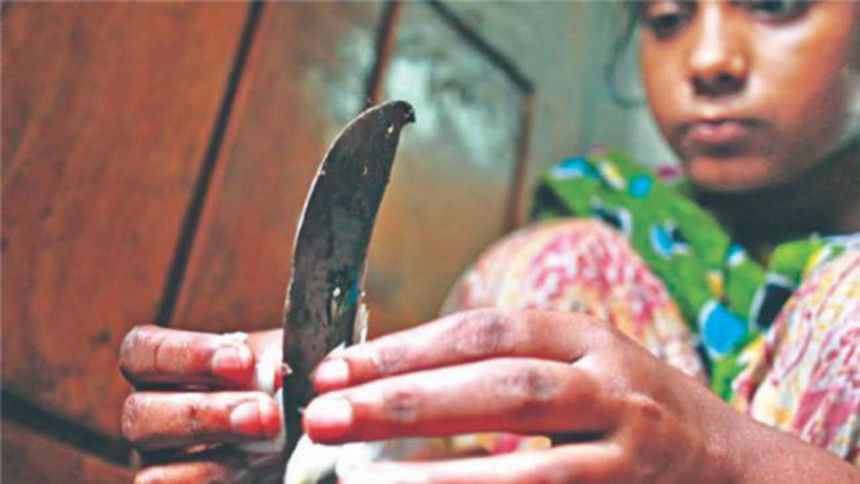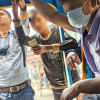Where is the law and humanity for children working in domestic settings?

Around a month ago, protests broke out in Uttara after the body of a 12-year-old child named Boishakhi was recovered from a home in Sector 3, hanging from the ceiling fan. Boishakhi's relatives claimed that this was a staged suicide because the girl had just gone back to work from a holiday. Protests broke out because no one could believe that a healthy girl, who was dropped off only the day before, could hang herself the next day. Although the employers have denied any wrongdoing, it is most likely another case of domestic worker abuse that led to the death of a child. A case was lodged.
In another recently reported case, child domestic worker Lamia, an 11-year-old, was frequently tortured by her employers, Ashraful Islam Chowdhury and his wife Sharmin Akhter, at their house in Barishal. Her employers used extreme measures to control her, like shaving her head so that her hair would not fall on food. The little girl was kept at her employer's house against her will. She was found attempting to escape from her building through the window, as her employers used to lock her up inside a room. Lamia was rescued in an unconscious state by the police, with a bruised face and injury marks all over her body.
Lamia and Boishakhi's cases are fresh reminders that there is much work to be done to protect these children. Children's engagement in domestic work is one of the worst forms of child labour and it is widespread in Bangladesh. According to a baseline survey (BBS & Unicef, 2006), there were approximately 400,000 child domestic workers aged between 6-17 years in Bangladesh, of which around 132,000 were in Dhaka city alone. This estimation makes domestic work by children the single largest hazardous child labour sector in the country. Almost 80 percent of child domestic workers are girls. As child domestic workers belong to the informal labour sector, they are often excluded from legal protection which makes them even more vulnerable. A Bangladesh Shishu Adhikar Forum (BSAF) (2010) study on the situation of child domestic workers in Dhaka city showed that almost 73 percent of child domestic workers experienced physical abuse and a significant number of children (17 percent) were sexually abused.
It was only since 2015 that the government introduced the Domestic Workers Protection and Welfare Policy to recognise the need for a framework of rights of domestic workers. The policy acknowledged domestic work as a profession and set 14 years as the minimum age for light work whereas for heavy work, the age set is 18 years and above.
Even where legal protections do exist, they are often little known and poorly implemented. Domestic workers tend to be unrecognised, under-paid and unable to access complaint procedures, more so if they are children. The hidden nature of domestic work means it often escapes the reach of the law and heightens the risk of abuse of workers at the hands of their employers. Thus child domestic work, in terms of policymaking, remains highly neglected because of the relatively invisible nature of such work. They are often far from their families; controlled by their employer; invisible to public authorities; frequently deprived of basic rights, related social services, decent lodging and working conditions; and vulnerable to sexual harassment and mental and physical abuse. It is also fair to deduce that any official complaints or reports to the police from child domestic workers would be ignored. How often do we give credibility to what children have to say, especially those hailing from poor socioeconomic backgrounds?
Children from poor and marginalised communities in Bangladesh are victims of non-cooperation and social hostility. Approximately 1.2 million children in Bangladesh are working in the worst forms of child labour, according to the National Child Labour Survey report, published in 2015. Many of these children are frequently abused and exploited in many ways by different quarters, including his/her family even. Despite a number of policies and laws, children, particularly from the disadvantaged segment of the society, are being abused across all social classes, and it is completely socially accepted.
Firstly, there is an enormous body of research showing that hitting children turns them into angry, resentful adults with psychological and emotional problems. Entire generations are perpetually cultivated through violence and absent of access to basic rights such as their childhood and education.
Secondly, it also highlights a savage, sadistic tendency among the authoritarian class in question, long sustained by social acceptance since the era of the landowning zamindari class' reign. As the zamindars rose to socioeconomic prominence during British rule, so have the upper classes today retained the false yet deeply ensconced sense of supremacy over the working class people, including the latter's bodies. It is as if the trans-Atlantic slave trade culture from the days of European colonies had been carried on as legacies, from brutalising Africans on the basis of race to now dehumanising domestic workers, including children, on the basis of their socioeconomic standing.
In fact, given the historical links between domestic work and slavery and other forms of servitude, child domestic workers are particularly vulnerable to violations of fundamental rights at work. Slavery is a system under which people are treated as property to be bought and sold, and are forced to work (Brace, 2004). One of the key issues distinguishing domestic work from other types of child labour is the 24-hour nature of the job (Black, 1997, p. 10). Typically, there are no specified hours or tasks allocated to child domestic workers. They do what their employer asks them to, at any time of day or night.
According to a study conducted by BSAF, the severity of torture on child domestic workers ranges from inhuman working hours with no rest to constant beatings and torture (such as hitting the head against the wall, branding lit cigarettes and hot metal objects against raw skin, etc), while some child domestic workers have even been raped and as a result committed suicide ("A Desk Review on Child Labour in Domestic Work in Bangladesh", Bangladesh Shishu Adhikar Forum, December 2013). It is important to note that abuse need not be physical in order to amount to torture. Torture can also be of an economic or mental nature (from non-payment of wages to incessant verbal abuse and infliction of trauma) and therefore needs to be recognised and condemned all the same.
Child domestic work is a child labour issue, a children's rights issue, and gender issue. It is a child labour issue as it involves economic exploitation and hazardous working conditions. It is a children's rights issue because the nature and conditions of the work are unfavourable for child development. Finally, it is also a gender issue as it relates to sexual abuse, risk of sexual assault, and family perceptions about the limited value of children's education. Often the child domestic workers are girls, as their parents send them to work at domestic settings to save up for their dowry.
So, when are we going to finally begin legal and social movements to topple the cultural acceptance of inhuman treatment of children on the basis of their class of birth? On a social level, we must first begin to check our own privileges and each other's—discouraging one another to employ children in our homes. And even if we are, keeping each other in check—how humanely are we treating domestic workers, especially children? In Bengali culture, we shame one another into avoidance in many aspects. So, why don't we apply cultural tools to shame those who abuse child domestic workers?
Dibarah Mahboob is an artist and writer covering mostly gender, human rights and socioeconomic issues. She has worked on empowerment and wellbeing of refugees in Jordan and Cox's Bazar through art and communications.

 For all latest news, follow The Daily Star's Google News channel.
For all latest news, follow The Daily Star's Google News channel. 








Comments